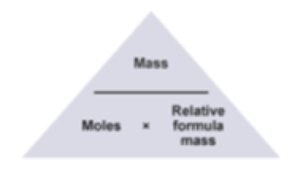Moles & Avogadro's Constant (GCSE Chemistry)
Moles & Avogadro’s Constant
Moles (GCSE Chemistry)
Moles and Mass
- We use moles for measurements. The main measure of chemical amounts are moles, with mol as the unit.
- We can compare moles to relative formula mass. The mass of one mole of a substance is equal to the relative formula mass in grams. For example, Boron has an Ar of 11, so one mole of Boron would weigh 11g exactly.
Avogadro’s Constant
- A mole is a number. The word “mole” stands for a particular number. This is known as the Avogadro Constant. Just as the word”dozen” represents the number “12”, the mole represents the number represented by Avogadro’s constant.
- The Avogadro constant is a number. The Avogadro constant is the number of atoms, molecules or ions in a mole of the given substance. We state it as 6.02 x 1023 atoms per mole.
- Avogadro’s number and moles. One mole of any substance contains 6.02 x 1023 particles. To determine the number of moles in a given number of particles, we can use the equation: –
Number of moles = (given number of particles/ 6.02 x 1023)
Worked example: Calculate the number of moles of chlorine (Cl2) in 3.01 x 1025 particles.
Number of moles = given number of particles/ 6.02 x 1023
Number of moles = 3.01 x 1025/ 6.02 x 1023 = 50 mol
Moles apply to all particles – we can use moles to measure out atoms, molecules, ions, electrons, formulae and equations.
As we’ve discussed previously, one mole is always the same number. If we have two substances, each being an amount of 1 mole, both substances would have the same number of particles.
Calculations Using Moles
If we wanted to calculate the number of moles of an element or a compound, we could use this formula:
Mr = formula mass of any given substance
Practice Question: Work out the number of moles in 150g of Calcium carbonate (CaCO3).
1.Calculate the Mr of Calcium carbonate.
First we need to calculate the relative formula mass of calcium carbonate, or (CaCO3).
Mr (CaCO3)
=40 + 12 + (3 x 16)
=100
2. Now we use the formula: Moles = Mass / Mr
Moles = 150 / 100
= 1.5 mol
Rearranging Formulae

Sometimes, the exam question might ask you to find the mass of a substance when given the moles and relative formula mass. To do this, we can use the triangle to help rearrange a formula.
To find mass, cover it up. Place your finger on top of the word ‘mass’ in the triangle. This leaves you will ‘moles x Mr’, which is the formula to work out the mass in this situation.
Practice Question: What mass of sodium is present in 3 moles of sodium chloride? State the units in your answer.
1.Rearrange the equation.
Here, we want to find the mass of sodium, so we can rearrange the formula we were using previously.
Mass = moles x Mr
2. Find the number of Mr and moles.
In 3 moles of sodium chloride, there are 3 moles of sodium. The Mr of sodium is 23.
Mr of sodium is 23
Mass = moles x Mr
Mass = 3 x 23
Mass = 69
3. State the units.
It’s important to answer the question fully, so remember to state the units of grams when using moles..
Mass = 69 grams.
We now have two ways of working out moles. One mole is the formula mass (Mr) of any substance in grams, and it is Avogadro’s number. Putting these two together, we can say that in one mole of the mass of any substance, there are 6.02 x 1023 particles.
We can use the equations to find the number of particles in any given mass of substance:
Number of moles = Mass/ Mr = given number of particles/ 6.02 x 1023
Worked example: Calculate the number of atoms in 450 g of chlorine (Cl2)
Answer:
1.Calculate the number of mole of chlorine in 450 g.
Mr of chlorine (Cl2) = 35.5 + 35.5 = 71
Moles Cl2 = 450/71 = 6.34 mol
2. Work out the number of Cl2 molecules in 6.34 mol.
number of particles = no of mol x 6.02 x 1023 = 6.34 x 6.02 x 1023 = 3.82 x 1024
3. Work out the number of atoms.
Chlorine has 2 atoms in each molecule
Therefore, there are 2 x 3.82 x 1024 = 7.64 x 1024
FAQs
In GCSE Chemistry, a mole is a unit of measurement used to express the amount of a substance in a sample. One mole of a substance is defined as the amount of that substance that contains the same number of particles (atoms, molecules, ions, or other entities) as there are in exactly 12 grams of carbon-12. This number of particles is known as Avogadro’s constant, which has a value of approximately 6.02 x 10^23 particles per mole.
The mole is a fundamental concept in chemistry and is used to relate the mass of a substance to the number of particles it contains. For example, the molar mass of a substance is the mass of one mole of that substance, and it is expressed in grams per mole.
To calculate the number of moles of a substance in a given sample, we divide the mass of the sample by the molar mass of the substance. For example, if we have a sample of sodium chloride (NaCl) weighing 58.44 grams, we can calculate the number of moles of NaCl as follows:
Number of moles of NaCl = Mass of NaCl / Molar mass of NaCl
Number of moles of NaCl = 58.44 g / 58.44 g/mol
Number of moles of NaCl = 1 mole
Therefore, the sample contains one mole of NaCl, which is equivalent to Avogadro’s constant number of particles (6.02 x 10^23 particles).
Avogadro’s number is a fundamental constant in chemistry that is used to determine the number of entities in a mole of a substance. It is defined as 6.02 x 10^23.
particles in a given amount of substance. It is denoted by the symbol “N” or “L” and has a value of approximately 6.02 x 10^23 mol^-1.
In GCSE chemistry, Avogadro’s constant is often used in calculations involving the mole concept, which is a way of counting and measuring the amount of a substance in a given sample. The mole is defined as the amount of substance that contains the same number of particles (atoms, molecules, ions, or other entities) as there are in exactly 12 grams of carbon-12.
For example, if we have one mole of a substance, we know that it contains Avogadro’s constant number of particles. Therefore, we can use Avogadro’s constant to convert between the number of particles, the amount of substance (measured in moles), and the mass of the substance.
Avogadro’s constant is an important constant in chemistry and is used in many applications, such as in stoichiometry, gas laws, and chemical kinetics.
The mole is important in chemistry because it allows us to quantify the amount of a substance in a more meaningful way than just using its mass. The mole allows us to determine the number of entities, such as atoms or molecules, in a given amount of a substance.
The mole is used in chemical reactions to determine the ratio of reactants and products in a reaction. The mole allows us to calculate the amount of each reactant and product required to perform a reaction.
Avogadro’s constant is the number of entities in a mole of a substance. It allows us to determine the number of entities in a given amount of a substance when expressed in moles.
Avogadro’s constant can be used in chemistry to calculate the number of entities in a substance, such as atoms or molecules. This information can be used to determine the stoichiometry of chemical reactions, which is the ratio of reactants and products in a reaction.
Avogadro’s constant is important in understanding chemical reactions because it allows us to determine the amount of reactants and products in a reaction. This information is essential for understanding the underlying chemical processes in a reaction and predicting the outcomes of reactions.
Avogadro’s constant can be used to determine the formula of a compound by determining the ratio of the elements in a compound. This information can be used to calculate the number of entities of each element in a given amount of a substance expressed in moles.
Avogadro’s constant is considered a fundamental constant in chemistry because it is a basic building block of the mole and is used in many chemical calculations. It is a fundamental part of our understanding of chemistry and the way we express the amount of a substance.






Still got a question? Leave a comment
Leave a comment